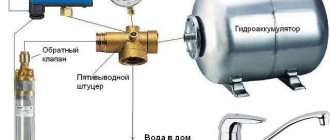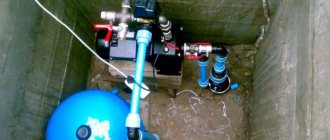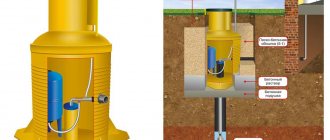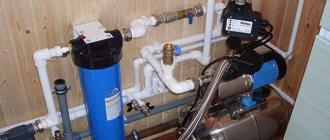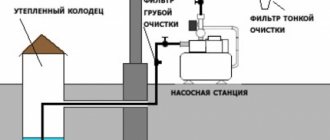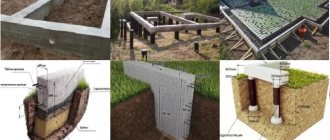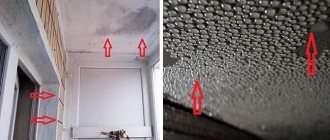When equipping an individual hydraulic extraction point on a site (for example, a well or well), it is also necessary to install a hydraulic accumulator. This is a storage tank with a complex device, an integral part of which is a small device used to measure the liquid level in the storage tank. In the article we will talk about the water pressure switch for a submersible water pump (pumping station) in the water supply system, we will talk about adjusting and configuring the sensor according to the instructions.
Technical device
To understand how this part works, you need to consider the entire structure of the water supply as a whole. The liquid enters the hydraulic accumulator. This is a container that is divided into two parts by a membrane partition. One contains compressed air, the other contains liquid. In this way, the volume can be adjusted; as a rule, no more than 40% -50% of the total capacity of the tank is pumped.
Household appliances that are included in the home water supply system can usually operate within the range of 1.4 to 2.8 atmospheres. To maintain this range, so that there are no breakdowns of water heaters, dishwashers and other electrical assistants in the home, a sensor is needed. But there are no strict standards for this indicator; the user can independently adjust the water pressure switch and adjust his own values.
The mechanism has two limits - these are the upper and lower limits, respectively, when the atmosphere becomes more and less than required, the device is triggered. When new fluid does not arrive, the old fluid is consumed from the storage tank. And when its level drops, the equipment will turn on again.
Now let’s get closer to how the relay itself looks and works. The basis is a mechanism operating on a hydraulic principle. This is a sensitive membrane that is attached to metal springs - one larger, the other smaller. When the pressure increases, the thin partition transfers stress to the metal base. The spring mechanism, in turn, is connected to the electrical unit. It consists of two terminals. When the spring is pressed, they close the contact and then open it. This turns the pump on and off.
It is important to note two points about the device:
- All electrical parts are reliably protected from moisture and are located under a special cap at the top of the sensor. The cable is inserted exactly under the terminals, it is also insulated from any liquid.
- The outlet of the hydraulic unit, that is, the membrane cover, is located on the rear side. There is also a mount here. It can be a classic threaded one, which is sometimes not very convenient, or with a union nut.
How to configure the relay correctly?
There is a cover on the body of the pressure switch, and under it there are two springs equipped with nuts: large and small. By rotating these springs, they set the lower pressure in the accumulator, as well as the difference between the on and off pressure values. The lower pressure is regulated by a large spring, and the small one is responsible for the difference between the upper and lower pressure.
Under the pressure switch cover there are two adjustment springs. The large spring regulates the activation of the pump, and the small one regulates the difference between the on and off pressure
Before starting the setup, it is necessary to study the technical documentation of the pressure switch, as well as the pumping station: the hydraulic tank and its other elements.
The documentation indicates the operating and limit values for which this equipment is designed. During adjustment, these indicators should be taken into account so as not to exceed them, otherwise these devices may soon break.
Sometimes it happens that while setting the pressure switch, the pressure in the system still reaches the limit values. If this happens, you simply need to turn off the pump manually and continue tuning. Fortunately, such situations are extremely rare, since the power of household surface pumps is simply not enough to bring the hydraulic tank or system to its maximum performance.
On the metal platform where the adjusting springs are located, the designations “+” and “-“ are made, which allow you to understand how to rotate the spring to increase or decrease the value
It is useless to adjust the relay if the accumulator is filled with water. In this case, not only the water pressure will be taken into account, but also the air pressure parameters in the container.
To adjust the pressure switch, you need to do the following:
- Set the operating air pressure in the empty accumulator.
- Turn on the pump.
- Fill the tank with water until the lower pressure is reached.
- Turn off the pump.
- Rotate the small nut until the pump starts.
- Wait until the tank is filled and the pump turns off.
- Open the water.
- Rotate the large spring to set the cut-in pressure.
- Turn on the pump.
- Fill the hydraulic tank with water.
- Correct the position of the small adjustment spring.
You can determine the direction of rotation of the adjusting springs by the “+” and “-” signs, which are usually located nearby. To increase the activation pressure, the large spring should be rotated clockwise, and to decrease this indicator, it should be rotated counterclockwise.
The adjusting springs of the pressure switch are very sensitive, so they need to be tightened very carefully, constantly checking the condition of the system and the pressure gauge readings
When adjusting the pressure switch for the pump, the rotation of the adjusting springs must be done very smoothly, approximately a quarter or half a turn; these are very sensitive elements. When turned back on, the pressure gauge should show lower pressure.
Regarding indicators when adjusting the relay, it will be useful to remember the following points:
- If the hydraulic tank is filled and the pressure gauge readings remain unchanged, it means that the maximum pressure in the tank has been reached, the pump should be turned off immediately.
- If the difference between the switch-off and switch-on pressure values is about 1-2 atm, this is considered normal.
- If the difference is greater or less, the adjustment should be repeated taking into account possible errors.
- The optimal difference between the set lower pressure and the pressure in the empty accumulator determined at the very beginning is 0.1-0.3 atm.
- The air pressure in the hydraulic accumulator should not be less than 0.8 atm.
The system can turn on and off regularly in automatic mode and with other indicators. But these limits make it possible to minimize the wear of equipment, for example, the rubber insert of the hydraulic tank, and extend the operating time of all devices.
Types and varieties
The design may differ from that described above due to other types. All products must first be classified into:
- Mechanical models. Its device is just described above. These are two springs, a movable membrane partition and a block with contacts. It is worth noting such advantages as the stability of the mechanism, as well as its simplicity. And the simpler the design, the less likely it is to break and the easier it is to repair. Therefore, the part can be called quite easy to handle. If there is a “dry running” sensor, that is, a complete shutdown of the equipment in the absence of liquid, then restarting is done manually. It is worth noting that on mechanical water pressure regulators for the pump, precise adjustment is more difficult.
- Electric models. They are distinguished by increased accuracy of values and ease of setup. They have a slightly higher cost. At the core is a flow controller. It is he who transmits the impulse to stop the pumping equipment. An additional advantage is the additional presence of a small hydraulic tank. This fluid supply helps protect the entire installation from water hammer. However, there is also a negative feature - increased sensitivity to impurities. If you install an electric relay, then you must install filters in front of it. Filtration equipment can be ordered from – we supply products for domestic and commercial use.
Another constructive distinction is that the sensor can be:
- Powerful. It carries out the process of activating and switching off the pump.
- Managers. They only transmit information and are also responsible for the operation of the pumping station.
In addition to design features and purpose, all relays can be distinguished by technical indicators:
- according to the maximum achieved pressure in the water utility;
- along the lower similar border;
- according to the volume of the hydraulic accumulator with which the device is compatible;
- by power - this parameter must be correlated with the throughput capacity of the equipment;
- in terms of manufacturer - Russian and Chinese models are not always inferior to European ones, but it is worth highlighting countries of production such as Denmark, Germany, Italy.
Here is a comparison table of popular models:
| Country of Origin | Name | Protection class, IP | Cost, rub. | Lower and upper limits of pressure, atm | Initial setting, atm |
| Italy | Italtecnica РМ/5G (m) 1/4″ | 44 | From 1 900 | 1 –5 | 1,4–2,8 |
| Germany | Grundfos (Condor) MDR 5-5 | 54 | From 3 800 | 1,5 – 5 | 2,8– 4,1 |
| Italy | Italtecnica PT/12 (m) | 44 | From 1900 | 1 –12 | 5 – 7 |
| Spain | Genebre 3781 1/4″ | – | From 500 | 1 – 4 | 0,4 – 2,8 |
| Italy | Italtecnica PM53W 1″ | – | From 500 | 1,5 – 5 | – |
| Russia | RDM-5 Gilex | 44 | From 900 | 1 – 4,6 | 1,4 — 2,8 |
Operating principle and device
Pressure switch device
The pressure switch was invented at the beginning of the last century. Until today, its design has changed little, and the principle of operation has not changed.
The sensor consists of the following elements:
- contact block;
- a spring that regulates the pressure difference (lower threshold);
- large working pressure springs (upper threshold);
- connection point for electrical wires;
- input for connecting a pressure gauge and safety valve;
- hole for membrane;
- on/off button;
- plastic or metal case.
In case of some breakdowns, it is necessary to replace the pressure switch, since repairing it is impractical or expensive. To do this, you need to know how to choose the right device, because manufacturers do not always supply parts for the required model. The policy is aimed at encouraging people to buy a new pump rather than repair the old one.
To select a device, you need to know its type, functionality and operating pressure - it is advisable not to lose the instructions for the pumping station. There are relays for water intake devices, air and chemical pumping control. A domestic pumping station usually works with clean water, less often with sewage or dirty liquid.
The presence of protection against overheating of the electric motor may be included in the relay circuit, but this type will cost more. If possible, it is better to buy a device with protection, since the pumping station itself is much more expensive.
There is a single-phase or three-phase relay. They are used in pumping stations to protect against dry running. This is a kind of sensor that responds to the power factor generated by the equipment. When the readings are low, the device turns off the pump. This is an additional feature, the presence of which makes the device more expensive.
To attach the new relay to the pump, you need to know the flange size. It can be indicated by the following numbers: ¼, ½, 3/8.
Some devices have a mechanical start button. It is designed to force the pressure sensor on or off. Other additional features include an unloader valve and a setting scale.
The operating range of the pressure switch must match that required by the parameters of the pumping station. In the instructions, it is usually indicated by strokes.
How to set the pressure on the relay depends on the operating principle
It all depends on what kind of installation we have in front of us - mechanical or electrical. Since in most cases it is the mechanics that are purchased (it is quite accurate and more affordable), let’s talk about it.
MBFT-75 Membrane for 75GPD
SF-mix Clack up to 0.8 m3/h
SF-mix Runxin up to 0.8 m3/h
An individual water treatment and water supply installation is most often installed on a private plot of land. It consists of a well, pumping equipment, a pipeline and a hydraulic accumulator with a sensor. The tank collects liquid, which is then consumed. This allows you to achieve an uninterrupted supply of liquid, as well as a stable pressure. In addition, a serviceable relay allows you to reduce the number of times the equipment is turned on, thereby extending its service life.
The operating principle of the equipment is as follows:
- The hydraulic accumulator runs out of fluid, and at the same time the pressure drops below the Rstart parameter, for which a large spring is responsible. Its pressure on the membrane displaces the terminals and closes them.
- The installation is operating, liquid fills the storage tank. As a result, the indicator increases and exceeds the specified parameters - P stop. A small spring acts on the membrane partition and opens the contacts. The fluid supply stops.
- When a resource is consumed (someone opened a tap in the house, turned on household appliances), the release is activated again to maintain a constant amount of H2O in the tank.
This determines how to adjust the pressure switch at the pumping station, that is, what maximum and minimum settings to set. If there were no sensor, then this on and off cycle would have to be done manually.
Pumping station design
In order to correctly adjust this pumping equipment, you must have at least a minimal understanding of how it works and on what principle it works. The main purpose of pumping stations, consisting of several modules, is to provide drinking water to all water intake points in the house. Also, these units are able to automatically increase and maintain the pressure in the system at the required level.
Below is a diagram of a pumping station with a hydraulic accumulator.
The pumping station includes the following elements (see figure above).
- Hydraulic accumulator. It is made in the form of a sealed tank, inside of which there is an elastic membrane. Some containers have a rubber bulb installed instead of a membrane. Thanks to the membrane (bulb), the hydraulic tank is divided into 2 compartments: for air and for water. The latter is pumped into a bulb or into a part of the tank intended for liquid. The hydraulic accumulator is connected in the section between the pump and the pipe leading to the water intake points.
- Pump. Can be surface or borehole. The pump type must be either centrifugal or vortex. The vibration pump cannot be used for the station.
- Pressure switch. The pressure sensor automates the entire process in which water is supplied from the well to the expansion tank. The relay is responsible for turning the pump motor on and off when the required compression force is reached in the tank.
- Check valve. Prevents fluid from leaking out of the hydraulic accumulator when the pump is turned off.
- Power supply. To connect the equipment to the electrical network, it requires a separate wiring with a cross-section corresponding to the power of the unit. Also, a protection system in the form of automatic circuit breakers must be installed in the electrical circuit.
This equipment works on the following principle. After opening the tap at the water intake point, water from the accumulator begins to flow into the system. At the same time, compression decreases in the tank. When the compression force decreases to the value set on the sensor, its contacts close and the pump motor begins to operate. After water consumption stops at the water intake point, or when the compression force in the accumulator increases to the required level, the relay is activated to turn off the pump.
Connecting equipment
During installation you will have to work with two systems. It is equally important to make the correct connection to both the electrical and plumbing. The installation will not move, so the place can be equipped as a stationary one, having previously provided easy access for repairs/maintenance.
Electrical part
It is best to allocate a separate line; this will extend the life of the device, however, this is not necessary. The copper cable must have a cross-section of no less than 2.5 mm. The sensor itself consumes little electricity, so the voltage value primarily depends on the power of the pump. You will definitely need to ground it, because the electricity + water set is not the safest option. You can follow this scheme when connecting:
When you open the cover on the back of the device, you will see three groups of contacts:
- Ground wires.
- “Line” for phase and zero, coming from the shield.
- The same contacts, but from pumping equipment.
When you have familiarized yourself with the schematic image, perform the standard actions - stripping the conductors, placing their edges in the connector, tightening the fastener. After half an hour or an hour, it is better to try tightening the bolts again, because the copper cable has some ductility.
Pipeline connection
This can be done in several ways, but most often a five-pin fitting is used as an adapter. If you don’t have a ready-made device at hand, you can assemble a similar part from classic fittings.
The pipe is attached to the relay body (there is an inlet at the bottom, under the membrane and springs), and the remaining holes are designed to connect the accumulator, hose and main water line. The last outlet can be used for a filter or pressure gauge. With it, setting up a water pressure switch for a pump in a water supply system becomes simple, since it is easier to adjust the sensor not by eye, but by the exact indicators of the device. And it is best to order complex filtration equipment.
Setting up the pressure switch
During the assembly of the pumping station, special attention is paid to setting the pressure switch. The ease of operation of the water supply system, as well as the trouble-free service life of all components of the device, depend on how correctly its limit levels are set.
At the first stage, you need to check the pressure that was created in the tank during the manufacture of the pumping station. Typically, at the factory, the switch-on level is set at 1.5 atmospheres, and the switch-off level is 2.5 atmospheres. They check this with an empty tank and the pumping station disconnected from the power supply. It is recommended to check with an automotive mechanical pressure gauge. It is housed in a metal case, so the measurements are more accurate than using electronic or plastic pressure gauges. Their readings can be affected by both the room temperature and the battery charge level. It is desirable that the pressure gauge scale limit be as small as possible. Because on a scale of, for example, 50 atmospheres, it will be very difficult to accurately measure one atmosphere.
To check the pressure in the tank, you need to unscrew the cap that closes the spool, connect the pressure gauge and take a reading on its scale. The air pressure should continue to be checked periodically, for example once a month. In this case, the water must be completely removed from the tank by turning off the pump and opening all taps.
Another option is to carefully monitor the pump shut-off pressure. If it increases, this will mean a decrease in air pressure in the tank. The lower the air pressure, the greater the supply of water can be created. However, the pressure spread from a completely filled to an almost empty tank is large, and all this will depend on the preferences of the consumer.
Having chosen the desired operating mode, you need to set it by bleeding off excess air, or pump it up additionally. It must be borne in mind that the pressure should not be reduced to less than one atmosphere, nor should it be over-pumped. Due to the small amount of air, the rubber container filled with water inside the tank will touch its walls and be wiped. And excess air will not make it possible to pump in a lot of water, since a significant part of the tank’s volume will be occupied by air.
When automation needs to be reconfigured
Sometimes equipment breakdowns or errors occur. Here are the most common:
- the liquid flow is not powerful enough due to the large suction depth;
- the pump impeller is worn out;
- seals are cracked or dried out;
- difficulties when supplying liquid to the upper floors of a high-rise building or to a tank that is mounted too high.
AMETHYST - 02 M Residential building for up to 10 people or up to 2 cubic meters/day.
Aeration unit AS-1054 VO-90
Main table dispenser AquaPro 919H/RO (hot and cold water)
In such situations, you will need to change the settings set by the manufacturer.
Preparation for the process
What you need to do first:
- fix problems with all water supplies;
- check the indicators in the expander chamber, everything should be adjusted to the lower limit on the relay;
- if necessary, pump up the air - in this case, excess liquid may spill out, this is normal.
What characteristics should be changed?
You can change two parameters:
- RStart.
- Δ P, that is, the difference between the upper and lower limits.
If you do not change the factory value of ΔP (usually it is equal to 1 atm), then when you move Pstart, at the same time Pstop changes by the same amount. Here is a table with the most common problems and options for how to configure the water pump relay:
| Situation | What are we moving? | How |
| Excessively frequent station startup | Increase Rstop | Compress the spring ΔР |
| Pump on too long | The stopping limit needs to be lowered | We lower ΔР while maintaining the starting point |
| The pressure is too high | Reducing Rpusk | We weaken the large spring, and the lower pressure limit automatically tightens |
| Water flows into the taps in a weak stream | Raise Rstart, leave Rstop in the same place | To do this, compress P, weaken ΔP |
Adjustment instructions
One of the most classic devices is the RDM-5 modification. From the factory it comes with settings of 1.4 atm and 2.8 atm. This is usually enough to install a house, but if you plan to install a jacuzzi, then the pressure should be higher.
There are two springs. The large one is for adjusting the upper and lower limits, and the small one is for changing the delta. You can change these parameters by tightening the nuts at the base (the pressure increases), or by unscrewing it - it becomes lower. If you do this with your hands and without measuring instruments, then usually one full revolution is equal to about 0.7 atm.
How to determine relay response thresholds
Usually they correspond to those stated in the instructions. But if the factory settings have been corrected or high accuracy is important to you, then testing can be done. To do this, remove the top cover, there will be a nipple there. You can connect a measuring device to it - a pressure gauge.
Settings
Sequencing:
- Connect the pressure gauge.
- Turn on the system and note on the device at what values it turns on and off.
- Tighten the nuts on the springs.
- Perform a test run again.
Main table dispenser AquaPro 929CH/RO (cooling/heating)
Floor dispenser AquaPro 311 (empty, without cooling)
Floor-standing dispenser AquaPro 6207CH (cooling/heating/room temp.)
This cycle can be performed several times until the most accurate results are obtained.
Accumulator pressure
It is formed due to the fact that the liquid presses on the membrane. Because of this, the air in the second part of the tank is compressed and puts more pressure on the body. To adjust this indicator, gas can be deflated or inflated through a regular nipple in the design, like in a car tire. Before connecting the relay, be sure to check and adjust the necessary indicators in the hydraulic tank. It should be equal to 1.5 bar.
Choosing the right connection diagram
The installation will definitely contain the elements shown in the picture. The connection will be made in this order:
- Water intake point (city pipeline or individual well).
- Filter.
- Hydraulic accumulator.
- Sensor.
- Additional filtration system.
- Faucet or other sources.
Manufacturer's choice
Above we have presented a specific list of models. Based on them, you can make a choice. Important criteria will be:
- Country of Origin;
- price;
- maximum and minimum limits.
Should we consider electronic analogues?
This is a more expensive alternative that is more accurate. This will be relevant in cases where the water supply network includes expensive equipment, plumbing equipment, as well as at production facilities.
conclusions
We have explained in detail what the structure of a hydraulic accumulator is, and why using it without a qualifier is a bad idea. They also gave detailed instructions for installing the equipment. You can make it yourself at home. To adjust the indicators you will not need any special knowledge or special items. After you unscrew the cover of the device with a screwdriver, everything else can be done manually. We hope that our article was useful and now you know how to correctly adjust the water pressure relay (sensor) for the water pump at the pumping station and in the home water supply system.
Features of relay settings
When buying a pumping station, many people want to immediately become familiar with its structure. Each of its elements is of considerable importance. The pressure switch is directly responsible for turning the pump off and on when certain pressure values in the hydraulic tank are reached.
A pressure switch is an element that regulates the water supply in the system. The relay turns the entire pumping system on and off. It is the relay that regulates the water pressure.
According to the principle of operation, relays are divided into electronic and mechanical. Using electronic relays is easier in terms of operation, but the service life of mechanical ones is longer. Therefore, mechanical relays are in great demand.
Relays can either be initially built inside the pumping station or come separately. Thus, according to the characteristics, you can easily select a relay for efficient operation of the pumping system.
Water inevitably contains foreign particles, and they are the main cause of failure of electronic relays. Therefore, it is better to use a special separate filter to purify water. The main advantage of using an electronic relay is that it prevents the pumping station from running idle. After turning off the water supply, the electronic device continues to work for some time. In addition, such relays are easier to configure and install.
Often pressure sensors have factory settings right away. As a rule, they are set to 1.5-1.8 atmospheres for switching on, and 2.5-3 atmospheres for switching off. The maximum permissible pressure value for the relay is 5 atmospheres. However, not every system can withstand it. If the pressure is too high, it can cause leaks, wear on the pump diaphragm, and other problems.
The initial adjustment is not always suitable for certain operating conditions of the station, and then you have to configure the relay yourself. Of course, for proper adjustment, it is best to become more familiar with what this small device is and how it works.
